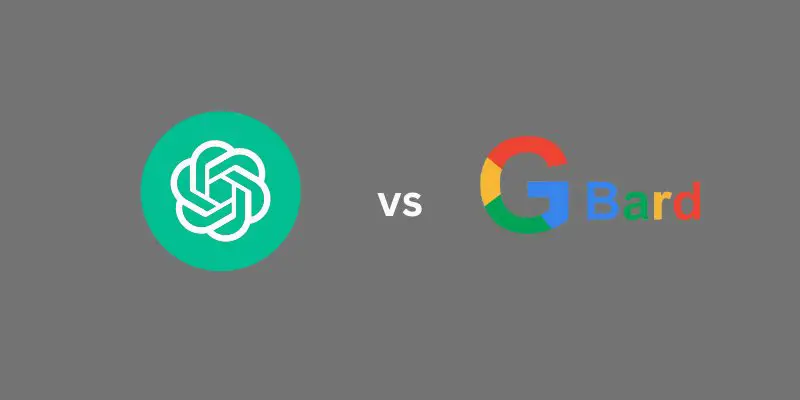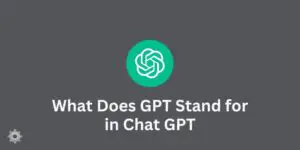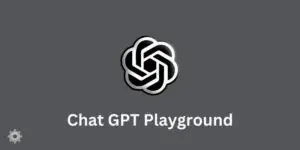Natural language processing (NLP) is no exception to the tremendous advances in AI.
Chatbots and virtual assistants have become an indispensable part of our everyday lives, aiding us with anything from booking flights to purchasing meals online.
ChatGPT and Google BARD are two of the most well-known NLP models that employ deep learning methods to understand natural language and provide appropriate replies to user inquiries.
They vary greatly, however, in terms of structure, training data, and application domains.
In this blog article, we will go further into ChatGPT and Google BARD, comparing their performance in different settings and discussing their distinctive features, strengths, and drawbacks.
You will have a better idea of which NLP model is the greatest match for your requirements and tastes after reading this article.
What is ChatGPT
ChatGPT is an AI-powered chatbot developed by OpenAI.
It is built on GPT-3, a machine learning model that can generate human-like text.
ChatGPT is designed to have conversations with users, answering questions and providing information2. It can be used for a variety of purposes, such as customer service, language translation, and content creation.
ChatGPT works by analyzing the text input by the user and generating a response based on its understanding of the input.
It uses natural language processing (NLP) to understand the meaning of the text and generate a relevant response.
ChatGPT is trained on a large dataset of text, which allows it to generate responses that are similar to human-generated text.
ChatGPT has been praised for its ability to generate high-quality responses and its potential to revolutionize the way we interact with technology.
However, there are also concerns about the potential misuse of AI-generated content and the ethical implications of using AI-powered chatbots.
Despite these concerns, ChatGPT and other AI-powered chatbots are likely to become increasingly common in the future as companies look for ways to automate customer service and other tasks.
What is Google Bard?
Google Bard is a new AI system developed by Google that presents conversational AI and how it is going to change the landscape for search.
Bard is a direct competitor to ChatGPT, which has been a leader in the AI race.
According to 9to5Google, Bard is a chatbot that can answer questions and engage in conversations with users.
There is not much information available about the specific features of Google Bard or how it works.
However, it is clear that Bard is an AI system that is designed to improve search and provide more conversational responses to user queries.
It is possible that Bard will be integrated into Google’s existing search engine or used as a standalone chatbot.
Overall, Google Bard appears to be an exciting development in the field of AI and natural language processing.
As more information becomes available about its capabilities and features, it will be interesting to see how it is received by users and how it impacts the search landscape.
ChatGPT vs Google Bard Comparison
Google Bard and ChatGPT are both AI language models that can generate human-like text.
There are several videos on YouTube that compare the two models. According to these videos, Google Bard is a newer model that was launched in 2021.
It is designed to be more conversational and can generate longer responses than ChatGPT.
Google Bard also has a more human-like tone and can understand context better than ChatGPT23. However, ChatGPT is more versatile and can generate text in multiple languages.
In terms of accuracy, the results are mixed. Some videos show that Google Bard generates more accurate responses than ChatGPT, while others show that ChatGPT is more accurate.
It is important to note that the accuracy of both models depends on the quality of the training data and the prompt given to the mode.
Overall, both Google Bard and ChatGPT are powerful AI language models that can generate human-like text. The choice between the two models depends on the specific use case and the user’s preferences.
| Feature | ChatGPT | Google BARD |
|---|---|---|
| Language Understanding | Uses a transformer-based model trained on large datasets to understand natural language input. | Uses a neural conversational model to understand natural language input. |
| Information Retrieval | Uses pre-trained knowledge and information retrieval techniques to provide relevant answers to questions. | Uses a knowledge graph and other information retrieval techniques to provide relevant answers to questions. |
| Language Generation | Generates natural language responses using a transformer-based model trained on large datasets. | Generates natural language responses using a neural conversational model. |
| Use Cases | Can be used for a variety of tasks, including language translation, content generation, and chatbot development. | Designed specifically for chatbot development and conversational AI applications. |
| Ethics and Privacy | OpenAI has made efforts to address potential ethical concerns, including limiting access to the full model and encouraging responsible use. | Google has also made efforts to address potential ethical concerns, including incorporating privacy and security features into the platform. |
ChatGPT vs Google Bard: What is the model parameter, and why is it important?
ChatGPT and Google Bard are two AI chatbots that use different language models to generate responses.
ChatGPT uses GPT-4 technology, while Google Bard employs its own language model for dialogue applications called LaMDA.
The language model is important because it determines the chatbot’s ability to understand and respond to prompts.
The quality of the responses depends on the accuracy and versatility of the language model.
While both ChatGPT and Google Bard aim to give human-like answers to questions, they perform differently in various categories such as coding, creative writing, and factual retrieval.
ChatGPT vs Google Bard: What they have in common?
Google Bard and ChatGPT are both AI chatbots that use natural language processing to generate human-like responses to user input.
They are both designed to engage in conversations with users and provide helpful responses to their queries.
Both Google Bard and ChatGPT are part of a growing trend in AI development towards more advanced natural language processing and conversational AI.
They are both examples of how AI is being used to create more engaging and interactive user experiences, and they are both likely to be used in a variety of applications in the future.
ChatGPT vs Google Bard: Ownership
ChatGPT is developed by OpenAI, a San Francisco-based AI research lab, while Bard is produced and owned wholly by Google, a major tech company12.
Which one is the best, Google Bard or ChatGPT?
According to multiple sources, ChatGPT is generally considered to be the better AI chatbot compared to Google Bard.
ChatGPT is currently available for free, while Google Bard is only available to a select group of beta testers.
ChatGPT is said to be more accurate and advanced, with better context and the ability to handle follow-up questions.
However, Google Bard is noted for its ability to provide factual and real-time information.
It’s worth noting that both chatbots use natural language models, with Google Bard using Google’s internal LaMDA and ChatGPT using an older GPT-3 language model.
What are the Main Differences between ChatGPT vs Google Bard
ChatGPT and Google Bard are both AI language models that can generate text based on prompts. They have some similarities, but there are also some differences.
Some of the main differences include:
- Bard is better at generating longer responses and can handle more complex prompts.
- ChatGPT is better at generating more creative and diverse responses.
- Bard is more focused on generating responses that are factually accurate and informative.
- ChatGPT is more focused on generating responses that are engaging and entertaining.
Overall, both ChatGPT and Google Bard have their strengths and weaknesses, and which one is better depends on the specific use case and the type of text generation needed.
FAQs about Google Bard and ChatGPT
Let’s go through some of the Frequently Asked Questions below:
How do ChatGPT and Google BARD generate language?
Both ChatGPT and Google BARD generate language using natural language processing and machine learning.
ChatGPT is designed for natural language processing and text generation, while Google BARD specifically focuses on generating conversational responses.
Google BARD uses Google’s Language Model for Dialogue Applications (LaMDA) to provide more detailed responses to questions asked than a typical Google search.
ChatGPT is based on data that was mostly collected up until 2021, whereas Google BARD has the potential to use up-to-date information.
The main difference between ChatGPT and Google BARD is the data source, with Google BARD continually drawing information from the internet to provide the latest information.
What are the use cases for ChatGPT and Google BARD, and how do they differ from each other?
ChatGPT and Google BARD are both AI language models, but they have different use cases.
ChatGPT is designed to engage in conversational interactions with humans and provide informative and helpful responses.
It is used for answering direct questions with direct answers. On the other hand, Google BARD is designed to understand the context of queries and provide the most relevant search results.
It continually draws information from the internet, so it has the latest information. The main difference between ChatGPT and Google BARD is the data source.
ChatGPT’s sources end with 2021 data, so it is limited to newer research and information, while Google BARD will have more data to gather information in real-time by accessing the internet.
What is ChatGPT and how does it compare to Google BARD?
ChatGPT is an AI chatbot based on Large Language Models (LLM) that has been tested for applications in assessment and teaching in education.
Google BARD is not mentioned in the search results, but Google has a similar AI language model called GPT (Generative Pre-trained Transformer) that is used for natural language processing.
Both ChatGPT and GPT are LLMs that have been trained on massive amounts of text data, enabling them to process, analyze, and generate natural language.
However, a reliability analysis against human performance showed that the inter-reliability of OpenAI ChatGPT and Google Bard LLMs tools were low against the gold standard of human ratings.
What is the history of ChatGPT and Google BARD?
ChatGPT is an artificial intelligence chatbot developed by OpenAI and launched in November 2022.
It is built on top of OpenAI’s GPT-3 family of large language models and has been fine-tuned using both supervised and reinforcement learning techniques.
In response to the rise of ChatGPT, Google developed Bard, a conversational AI chatbot powered by LaMDA, which was released in a limited capacity in March 2023.
Bard generates text responses to questions asked based on information gathered from the web and is overseen by product lead Jack Krawczyk.
The development of these chatbots has increased competition in the space and has led to further advancements in conversational AI technology.
What are the key differences between ChatGPT and Google BARD?
ChatGPT and Google BARD are both AI chatbots based on large language models (LLMs) that have been used for various applications, including assessment and teaching.
However, they differ in their performance and reliability. In a study comparing the accuracy of different LLMs on a neurosurgery oral boards examination preparation question bank, ChatGPT (GPT-3.5) and GPT-4 outperformed Google BARD.
Another study measured the reliability of OpenAI ChatGPT and Google BARD LLMs tools against human raters and found that their inter-reliability was low.
Can you provide examples of language generation tasks performed by ChatGPT and Google BARD?
Both ChatGPT and Google BARD are AI language generation models that can perform various tasks.
Some examples of language generation tasks performed by ChatGPT include generating text for chatbots, summarizing text, and generating creative writing prompts.
On the other hand, Google BARD can perform tasks such as generating poetry, song lyrics, and even entire stories.
Additionally, OpenAI’s GPT-3 can be used to generate questions from sentences.
What are the future developments in the field of language models and conversational AI?
he field of language models and conversational AI is rapidly evolving, with many promising developments on the horizon.
Some of the future developments in this field include:
- Self-training, fact-checking, and sparse expert models.
- Enhancements to large-scale language models, such as Megatron-Turing Natural Language Generation (MT-NLG).
- More human-like interactions.
- Bootstrapping large language models to enable them to effectively analyze and reflect on the world via internal reflection.
These developments are likely to lead to more advanced and sophisticated language models that can perform a wide range of tasks, including question answering, document summarization, text generation, sentence completion, and translation.




